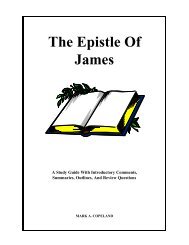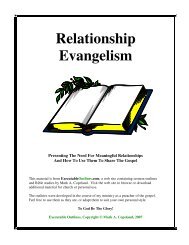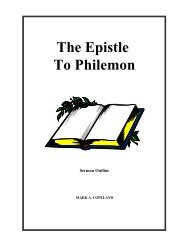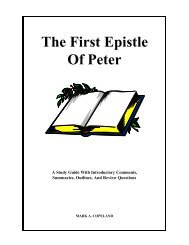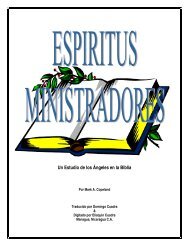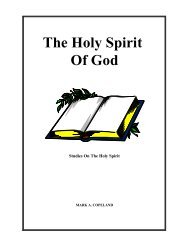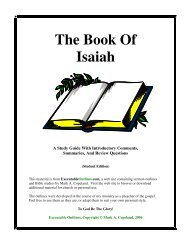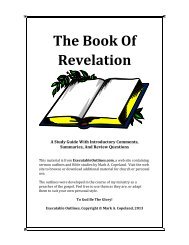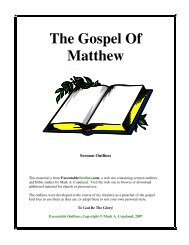The Epistle To The Hebrews - Executable Outlines
The Epistle To The Hebrews - Executable Outlines
The Epistle To The Hebrews - Executable Outlines
Create successful ePaper yourself
Turn your PDF publications into a flip-book with our unique Google optimized e-Paper software.
Mark A. Copeland<br />
b. <strong>The</strong> tenth day of the seventh month - Lev 16:29<br />
2. <strong>The</strong> high priest would do three things:<br />
a. Offer the incense to cloud the mercy seat - Lev 16:12-13<br />
b. Sprinkle the mercy seat with the blood of a bull, as a sin offering for himself and his<br />
family - Lev 16:11,14<br />
c. Sprinkle the mercy seat with the blood of a goat, as a sin offering for the people - Lev<br />
16:15<br />
3. In this way he offered blood for his own sins and those of the people committed in<br />
ignorance - He 9:7<br />
[With this summary of the ritual of the earthly sanctuary, we are reminded of the sort of services<br />
rendered under the first covenant. But was the true purpose of such service? And did the sacrifices<br />
provide complete redemption? <strong>The</strong>se questions are addressed in the next two verses...]<br />
III. THE EARTHLY SANCTUARY: ITS SYMBOLISM AND LIMITATION (8-10)<br />
A. IT WAS SYMBOLIC...<br />
1. As already stated, the tabernacle and its service was “a copy and shadow of the heavenly<br />
things” - He 8:4-5; cf. He 10:1a; Co 2:16-17<br />
2. Thus it was “symbolic for the present time” - He 9:9<br />
a. Symbolizing what eventually would occur when Christ came<br />
b. Symbolizing what Christ has now done in reality when He entered heaven - cf. He 9:<br />
11-12,24-26<br />
3. <strong>The</strong> Holy Spirit was thus indicating that “the way into heaven itself was not yet made<br />
manifest” - He 9:8<br />
B. THERE WERE LIMITATIONS...<br />
1. <strong>The</strong> gifts and sacrifices could not make one perfect in regard to the conscience - He 9:9;<br />
cf. He 9:14; 10:1-4<br />
2. <strong>The</strong> ceremonies involved “fleshly ordinances imposed until the time of reformation” - He<br />
9:10<br />
a. Just as the sanctuary was “earthly”, the ordinances were “fleshly”<br />
1) In contrast to that which is heavenly, spiritual<br />
2) Indeed, all of the ritual was designed to impact the physical side of man<br />
a) I.e., his senses (sight, sound, smell, taste, touch)<br />
b) E.g., the burning of incense, the blowing of trumpets, the vestments<br />
b. Such ordinances were designed to be temporary<br />
1) Until “the time of reformation”, when changes in worship would be made<br />
2) Indeed, now God expects “spiritual” worship - cf. Jn 4:21-24<br />
a) Worship that is more in keeping with God’s true nature (Spirit)<br />
b) Worship that focuses on the inner man<br />
1/ E.g., singing, where the emphasis is on melody made in the heart<br />
- cf. Ep 5:19; Co 3:16<br />
2/ Even in the Lord’s Supper, which has physical elements, the emphasis is on<br />
the communion we share in the body of and blood of Jesus as we<br />
commemorate His death - cf. 1 Co 11:23-26; 10:16-17<br />
-- <strong>The</strong>refore we should not be surprised to learn that the early church did not simply<br />
institute the fleshly ordinances of the first covenant into their worship<br />
Sermons From <strong>Hebrews</strong> 68



